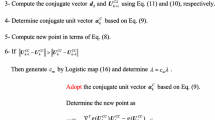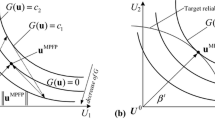Abstract
The HL-RF iterative algorithm of the first order reliability method (FORM) is popularly applied to evaluate reliability index in structural reliability analysis and reliability-based design optimization. However, it sometimes suffers from non-convergence problems, such as bifurcation, periodic oscillation, and chaos for nonlinear limit state functions. This paper derives the formulation of the Lyapunov exponents for the HL-RF iterative algorithm in order to identify these complicated numerical instability phenomena of discrete chaotic dynamic systems. Moreover, the essential cause of low efficiency for the stability transform method (STM) of convergence control of FORM is revealed. Then, a novel method, directional stability transformation method (DSTM), is proposed to reduce the number of function evaluations of original STM as a chaos feedback control approach. The efficiency and convergence of different reliability evaluation methods, including the HL-RF algorithm, STM and DSTM, are analyzed and compared by several numerical examples. It is indicated that the proposed DSTM method is versatile, efficient and robust, and the bifurcation, periodic oscillation, and chaos of FORM is controlled effectively.












Similar content being viewed by others
Abbreviations
- FORM:
-
First order reliability method
- STM:
-
Stability transfor `mation method
- DSTM:
-
Directional stability transformation method
- SORM:
-
Second order reliability method
- MPP:
-
Most probable point
- PMA:
-
Performance measure approach
- U-space:
-
Standard normal space
- SR1:
-
Symmetric rank-one
- LE:
-
Lyapunov exponent
- X :
-
Random variable vector
- U :
-
Normalized random variable vector
- U * :
-
Most probable point
- d :
-
Search direction
- β :
-
Reliability index
- μ :
-
Mean vector
- σ :
-
Standard deviation vector
- g(X):
-
Performance function
- ∇g(·):
-
Sensitivities of performance function
- J :
-
Jacobian matrix
- H :
-
Hessian matrix
- P f :
-
Failure probability
- Ф(·):
-
Cumulative distribution function
- f(·):
-
Iterative function vector
- C :
-
Involutory matrix
- λ :
-
Control factor
- qr[.]:
-
QR-factorization process
- ñ(U k):
-
Radial direction
- n ⊥(U k):
-
Circumferential direction
References
Armiyoon AR, Wu CQ (2015) A novel method to identify boundaries of basins of attraction in a dynamical system using Lyapunov exponents and Monte Carlo techniques. Nonlinear Dyn 79:275–293
Bae HR, Grandhi RV, Canfield RA (2006) Sensitivity analysis of structural response uncertainty propagation using evidence theory. Struct Multidiscip Optim 31:270–279
Basudhar A, Missoum S (2009) A sampling-based approach for probabilistic design with random fields. Comput Meth Appl Mech Eng 198:3647–3655
Danca MF (2015) Lyapunov exponents of a class of piecewise continuous systems of fractional order. Nonlinear Dyn 81:227–237
Du XP, Chen W (2004) Sequential optimization and reliability assessment method for efficient probabilistic design. J Mech Des 126:225–233
Gu L, Yang RJ, Tho CH, Makowski M, Faruque O, Li Y (2001) Optimization and robustness for crashworthiness of side impact. Int J Veh Des 26:348–360
Hasofer AM, Lind NC (1974) Exact and invariant second moment code format. J Eng Mech Div 100:111–121
Hu Z, Du XP (2015) First order reliability method for time-variant problems using series expansions. Struct Multidiscip Optim 51:1–21
Hubertus F, Udwadia FE, Proskurowski W (1997) An efficient QR based method for the computation of Lyapunov exponents. Phys D 101:1–16
Jiang C, Han S, Ji M, Han X (2015) A new method to solve the structural reliability index based on homotopy analysis. Acta Mech 226:1067–1083
Koduru S, Haukaas T (2010) Feasibility of FORM in finite element reliability analysis. Struct Saf 32:145–153
Lee I, Noh Y, Yoo D (2012) A novel second-order reliability method (SORM) using noncentral or generalized Chi-squared distributions. J Mech Des 134:100912
Lopez RH, Torii AJ, Miguel LFF, Souza Cursi JE (2015) Overcoming the drawbacks of the FORM using a full characterization method. Struct Saf 54:57–63
Lim J, Lee B, Lee I (2014) Second-order reliability method-based inverse reliability analysis using Hessian update for accurate and efficient reliability-based design optimization. Int J Numer Methods Eng 100:773–792
Liu PL, Der Kiureghian A (1991) Optimization algorithms for structural reliability. Struct Saf 9:161–177
Meng Z, Li G, Wang BP, Hao P (2015) A hybrid chaos control approach of the performance measure functions for reliability-based design optimization. Comput Struct 146:32–43
Petkov BH, Vitale V, Mazzola M, Lanconelli C, Lupi A (2015) Chaotic behaviour of the short-term variations in ozone column observed in Arctic. Commun Nonlinear Sci Numer Simul 26:238–249
Pingel D, Schmelcher P, Diakonos FK (2001) Detecting unstable periodic orbits in chaotic continuous-time dynamical systems. Phys Rev E 64:026214
Pingel D, Schmelcher P, Diakonos FK (2004) Stability transformation: a tool to solve nonlinear problems. Phys Rep 400:67–148
Rackwitz R, Fiessler B (1978) Structural reliability under combined random load sequences. Comput Struct 9:489–494
Reddy MV, Grandhi RV (1994) Reliability based structural optimization: a simplified safety index approach. Comput Struct 53:1407–1418
Santos SR, Matioli LC, Beck AT (2012) New optimization algorithms for structural reliability analysis. CMES Comput Model Eng 83:23–55
Schmelcher P, Diakonos FK (1998) General approach to the localization of unstable periodic orbits in chaotic dynamical systems. Phys Rev E 57:2739–2746
ur Rehman S, Langelaar M (2015) Efficient global robust optimization of unconstrained problems affected by parametric uncertainties. Struct Multidiscip Optim 52:319–336
Wen GL, Xu DL (2005) Nonlinear observer control for full-state projective synchronization in chaotic continuous-time systems. Chaos Solitons Fractals 26:71–77
Yang DX (2010) Chaos control for numerical instability of first order reliability method. Commun Nonlinear Sci Numer Simul 15:3131–3141
Yang DX, Li G, Cheng GD (2006) Convergence analysis of first order reliability method using chaos theory. Comput Struct 84:563–571
Youn BD, Choi KK, Yang RJ, Gu L (2004) Reliability-based design optimization for crashworthiness of vehicle side impact. Struct Multidiscip Optim 26:272–283
Youn BD, Xi Z, Wang P (2008) Eigenvector dimension reduction (EDR) method for sensitivity-free probability analysis. Struct Multidiscip Optim 37:13–28
Zhang Y, Der Kiureghian A (1995) Two improved algorithms for reliability analysis. In: Reliability and optimization of structural systems. Springer, Boston, p 297–304
Zhang J, Du X (2010) A second-order reliability method with first-order efficiency. J Mech Des 132(10):101006
Zhou CC, Lu ZZ, Zhang F, Yue ZF (2015) An adaptive reliability method combining relevance vector machine and importance sampling. Struct Multidiscip Optim 52:945–957
Acknowledgments
The supports of the Fundamental Research Funds for the Central Universities of China (No JZ2016HGBZ0751) and the National Natural Science Foundation of China (Grant Nos. 90815023 and 51021140006) are greatly appreciated. The authors also thank Professor Gengdong Cheng and Dr. Hao Hu for their comments and discussion.
Author information
Authors and Affiliations
Corresponding author
Rights and permissions
About this article
Cite this article
Meng, Z., Li, G., Yang, D. et al. A new directional stability transformation method of chaos control for first order reliability analysis. Struct Multidisc Optim 55, 601–612 (2017). https://doi.org/10.1007/s00158-016-1525-z
Received:
Revised:
Accepted:
Published:
Issue Date:
DOI: https://doi.org/10.1007/s00158-016-1525-z




